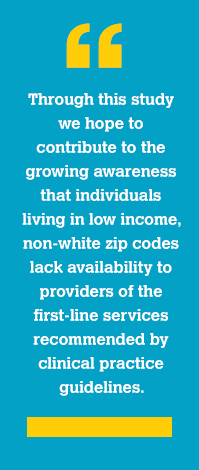

David Elton, VP of Musculoskeletal R&D at Optum Labs
After much anticipation, Optum Labs is releasing exciting new research related to the vast disparities in pain care that exist across geographically dissimilar zip codes in the United States: Geographic variation in the treatment of spinal disorders: association with health care professional availability, and population socioeconomic status, race, and ethnicity. A retrospective cohort study.
(Please note: This article is a preprint and has not been peer-reviewed [what does this mean?]. It reports new medical research that has yet to be evaluated and so should not be used to guide clinical practice.)
We recently discussed the new research with the paper’s lead author, AACIPM Advisory Committee member, David Elton, DC, to learn more about this important article, it’s intended purpose, and how it may impact the work of AACIPM’s stakeholders going forward.
AACIPM: What was the reason behind this study and article?
David Elton: At Optum Labs our objective is to translate unique data assets into insights and action focused on making the healthcare system work better for everyone. The context for this study is that spinal disorders are common, costly, and the #1 global cause of years lived with disability (YLD), yet less is understood about disparities in spine care than other conditions such as diabetes, obesity, or heart disease.
We were curious to explore variation in the management of spinal disorders at the level of 5-digit zip codes and look at associations with local population and environmental factors including population race/ethnicity, income, deprivation, and health care provider availability. The management of spinal disorders benefits from high quality clinical practice guidelines (CPG) that describe a stepped approach emphasizing non-pharmaceutical and non-interventional first-line therapies. Our hypothesis was that first-line services would be less available in lower income, non-white zip codes, which would be associated with greater use of inexpensive prescription pharmaceuticals.
AACIPM: Over the past years, you have discussed with AACIPM the fact that spinal disorders are common and associated with high rates of low value care. In March 2020, you shared your perspective on this in relation to Orthology during AACIPM’s focus group with Midwest Business Group on Health. You also presented during an AACIPM webinar later that year related to equity and access and some of the initial findings of the “zip code data” that lays the basis of this newly published article. Two years later, what does all this mean when it comes to promoting guideline-concordant care across many providers?
David Elton: The finding of disparities associated with population race/ethnicity, income, and deprivation was not a surprise. Addressing these disparities at scale, and even publication of these type of data, remains challenging. A variety of economic factors contribute to maintaining the status quo.
In low income, non-white zip codes where spinal disorders are managed with inexpensive pharmaceuticals, financially sustainable models for making CPG recommended first-line therapies available remain elusive. Creative, non-traditional partnerships may be promising for making first-line therapies available outside of the traditional solo or small practice model. Diversifying the workforce of providers like chiropractors and physical therapists may also be important.
In affluent, primarily white zip codes the abundance of CPG recommended first-line treatment options are overwhelmed by equal or greater availability and marketing of second- and third-line management options. A catalyst for change will likely need to involve transition away from transactional fee-for-service reimbursement to alternative reimbursement models that align management with CPG concordance and value.
AACIPM: At AACIPM, we often discuss the importance of how social determinants of health must be fully considered when integrating a BioPsychoSocial approach to care for people with pain. Have you learned anything new in this regard from your involvement in this work?
 David Elton: Implementing “evidence-based care”, while well-intended, is too high-level. Health care is local, even down to the 5-digit zip code. Strategies and tactics need to be fine-tuned to social determinants of health embedded within local environmental and population factors.
David Elton: Implementing “evidence-based care”, while well-intended, is too high-level. Health care is local, even down to the 5-digit zip code. Strategies and tactics need to be fine-tuned to social determinants of health embedded within local environmental and population factors.
This study looked at spinal disorders experienced in 2017-2019, pre-COVID, in a commercially insured population. Many things changed in early 2020, and it is not clear how much of what we learned in the study remains relevant in the post-COVID environment. We have just started work on replicating the study, looking at spinal disorders experienced in 2019-2021, with the cohort expanded to include Medicare Advantage (MA) and Medicaid members. We are curious to understand whether COVID increased disparities observed in the pre-COVID period and to compare experiences in commercially insured and MA and Medicaid cohorts. Finally, these data are derived from individuals who benefit from having insurance coverage for a range of health care services. An important area of research is exploring whether disparities identified in our study are amplified in those without insurance coverage.
AACIPM: What do you most hope that AACIPM stakeholders learn from this study?
David Elton: AACIPM has done a terrific job of bringing together a broad group of stakeholders focused on making the healthcare system work better for individuals living with pain. Through AACIPM we have learned of innovative, whole-person pain management programs responsive to the needs of local health care ecosystems. Through this study, we hope to contribute to the growing awareness that individuals living in low income, non-white zip codes lack availability to providers of the first-line services recommended by CPGs which is associated with a primary emphasis on inexpensive pharmaceutical, including opioid, management.
By drawing attention to the disparities in pain management through publication, and socializing through AACIPM, our hope is we can help more stakeholders learn about, optimize, and scale the innovation happening in the market.
AACIPM: Are there implications for innovation and progress that could lead to increased access to integrative pain management for people who are underserved?
David Elton: A pre-condition for access to integrative pain management (IPM) is availability of IPM services. Availability is a function of factors like insurance coverage for IPM services, geographic convenience, and ability/willingness to pay for any associated out of pocket costs.
The substantial and growing body of research supporting efficacy of IPM services like physical therapy, chiropractic manipulation, and acupuncture has resulted in fairly uniform coverage in commercial insurance, growing coverage in Medicare, and variable coverage in Medicaid programs. The research into efficacy of IPM services like yoga therapy, massage therapy, and mindfulness is promising yet less well-established resulting in sparse coverage. As our study illustrated, even if covered, IPM services like physical therapy, chiropractic and acupuncture may not be conveniently available, particularly in lower income, non-white zip codes. If covered and geographically convenient, there may be financial barriers where copays and deductibles associated with IPM services are higher than inexpensive pharmaceutical options.
Even if covered, conveniently available, and with a high ability/willingness to pay for IPM services, a barrier to access to these types of hands-on therapies may involve preferences for racial/ethnic concordance between the individual and the provider and/or cultural familiarity and acceptance of IPM services. These are dynamics requiring additional study, particularly with the physical therapy and chiropractic professions being overwhelmingly white and among the least diverse professions in health care.
Regarding implications for innovation and progress, we believe our research establishes that the following must occur to best support the use of effective IPM:
- Establish efficacy of IPM services like yoga therapy, massage therapy, and mindfulness
- Understand and address factors contributing to lack of availability of IPM services in lower income, non-white zip codes
- Quantify short and long-term trade-offs associated with higher out of pocket costs associated with CPG recommended first-line therapies vs. lower out of pocket costs associated with pharmaceutical therapies
- Understand importance of racial/ethnic concordance between the individual and the provider, and/or cultural familiarity with and acceptance of IPM services